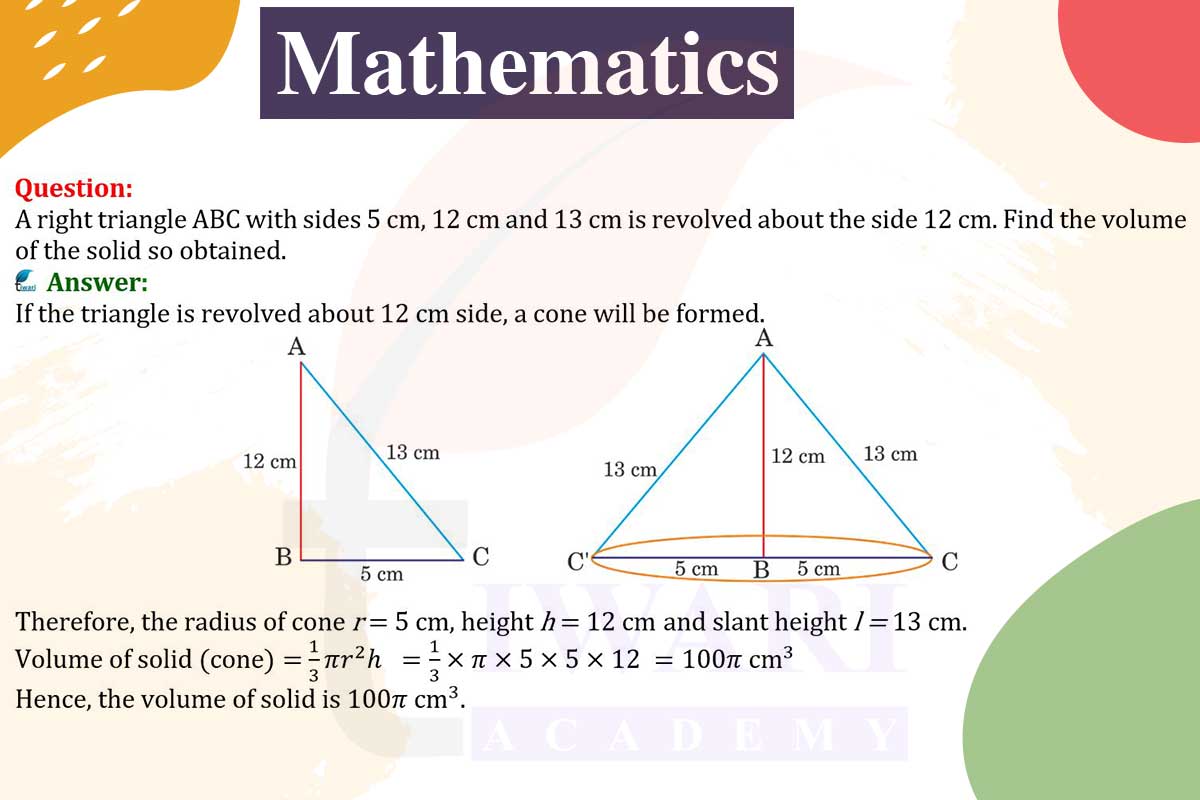When a right triangle is revolved around one of its sides, it forms a solid of revolution. In this case, revolving the triangle ABC with sides 5 cm, 12 cm, and 13 cm around the 12 cm side results in a cone. The 12 cm side becomes the height (h) of the cone, and the 5 cm side becomes the radius (r) of the base.
The volume of a cone is given by the formula V = (1/3)πr²h.
Substituting r = 5 cm and h = 12 cm, the volume V is calculated as V = (1/3)π × 5² × 12 cm³.
This calculation yields the volume of the solid formed by the revolution of the right triangle around its 12 cm side.

Let’s discuss in detail
Solids of Revolution
Solids of revolution are three-dimensional shapes created by rotating a two-dimensional shape around an axis. This concept is a fundamental aspect of geometric and calculus studies, illustrating how a simple two-dimensional figure can transform into a complex three-dimensional object. In this scenario, we consider a right triangle being revolved around one of its sides. This process is not just a theoretical construct but has practical implications in fields like engineering and design, where it helps in understanding the properties of objects created through rotational movements.
Understanding the Right Triangle ABC
The right triangle ABC in question has sides measuring 5 cm, 12 cm, and 13 cm, making it a Pythagorean triplet. This implies that the triangle is right-angled, with the sides adhering to the Pythagorean theorem. In such triangles, the longest side (hypotenuse) is opposite the right angle, and the other two sides are perpendicular to each other. When this triangle is revolved around one of its sides, it forms a solid of revolution, the nature of which depends on the side chosen for rotation.
Forming a Cone by Revolving the Triangle
Revolving the right triangle ABC around its 12 cm side results in the formation of a cone. In this process, the 12 cm side becomes the height (h) of the cone, and the 5 cm side becomes the radius (r) of the base. The 13 cm side, being the hypotenuse, does not directly contribute to the dimensions of the cone but is crucial in establishing the right-angled nature of the triangle. This transformation from a flat triangle to a three-dimensional cone is a fascinating aspect of geometric constructions.
Calculating the Volume of the Cone
The volume of a cone is calculated using the formula V = (1/3)πr²h, where V is the volume, r is the radius, and h is the height. In this case, with a radius of 5 cm and a height of 12 cm, the formula becomes V = (1/3)π × 5² × 12. This formula is a fundamental principle in geometry, enabling the calculation of the volume of conical shapes formed through rotation.
The Significance of the Calculation
This calculation is not just a theoretical exercise but has practical applications. For example, in industrial design and manufacturing, understanding how to calculate the volume of solids of revolution is crucial for material estimation, cost analysis, and design specifications. In academic settings, it helps students grasp the concepts of volume and the transformation of shapes, enhancing their spatial reasoning and understanding of geometry.
Geometric Transformations and Their Applications
In conclusion, the process of calculating the volume of a solid formed by revolving a right triangle around one of its sides demonstrates the fascinating interplay between two-dimensional shapes and three-dimensional objects. It highlights the importance of geometric principles in understanding and creating complex shapes and forms. This knowledge is not only academically significant but also essential in various practical fields, from engineering to design, showcasing the real-world applications of geometric transformations.
Discuss this question in detail or visit to Class 9 Maths Chapter 11 for all questions.
Questions of 9th Maths Exercise 11.3 in Detail


